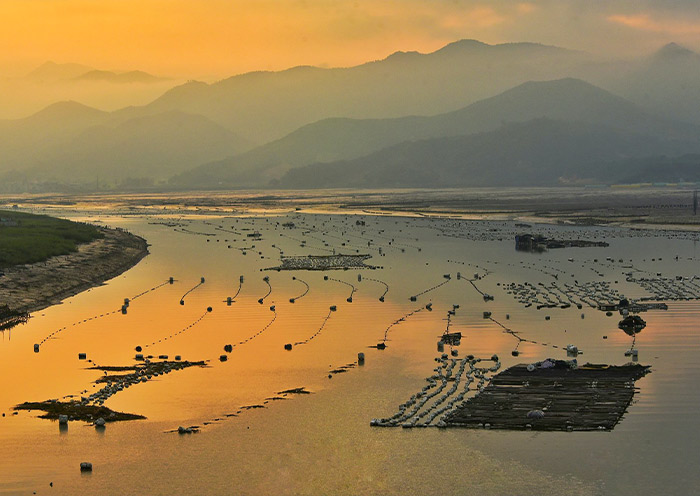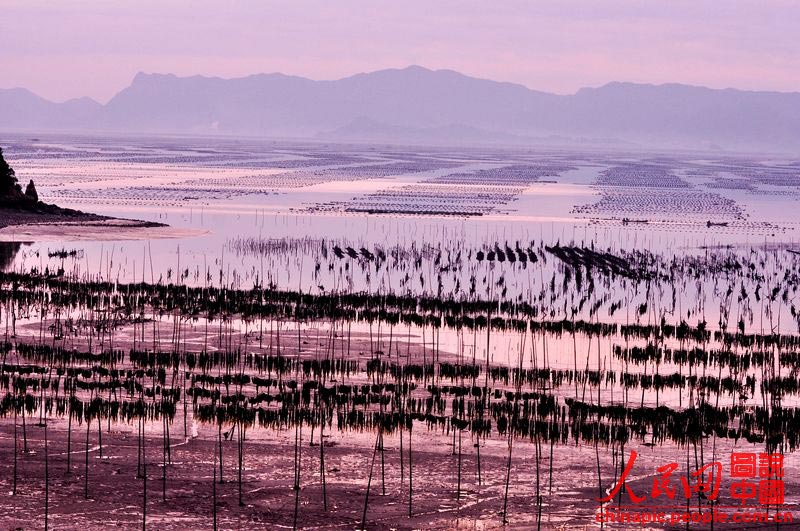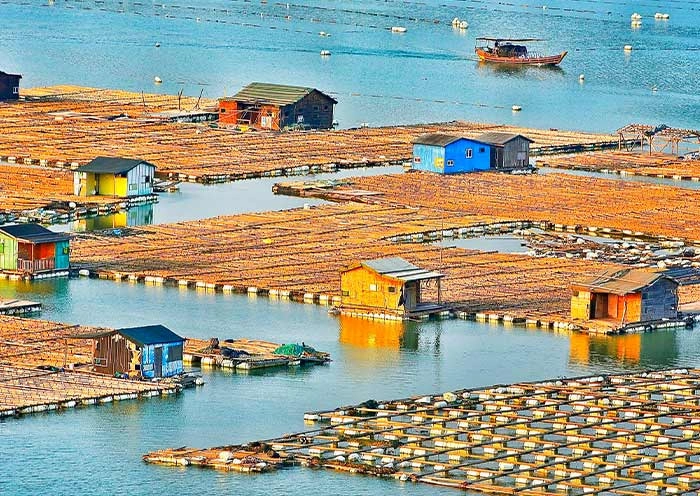Xiapu Mudflat: The Hidden Gem of China’s Coastal Wonders

An Essential Guide to Visiting Xiapu Mudflat
Nestled along the southeastern coast of China in Fujian Province, Xiapu Mudflat is a captivating blend of natural beauty and traditional rural lifestyle. This picturesque destination, often overlooked by international travelers, offers a unique glimpse into the age-old practices of fishing and farming that have sustained local communities for generations. As you stroll along the expansive mudflats, you’ll be enchanted by the ever-shifting scenery—where glimmering waters and rich, dark mud coexist in a delicate dance dictated by the tides.
Xiapu is a haven for photographers and nature lovers alike. The landscape transforms with each passing moment, showcasing the artistry of local fishermen as they cast their nets and harvest seaweed. Here, the rhythm of life is dictated by the ocean, creating a dynamic backdrop for capturing enchanting sunrises and sunsets that paint the sky in vibrant hues. The area is dotted with traditional bamboo structures, quaint thatched huts, and the gentle sound of waves lapping against the shore, inviting you to immerse yourself in its tranquil charm.
As you venture into this rural paradise, you’ll have the opportunity to engage with friendly locals, learn about their time-honored trades, and enjoy the simplicity of life in a region that feels like a step back in time. Whether you’re seeking a peaceful retreat from bustling urban centers or an authentic cultural experience, Xiapu Mudflat awaits with open arms and endless stories to share.
In This Guide
- An Essential Guide to Visiting Xiapu Mudflat
- The Rich History and Legends of Xiapu Mudflat
- Main Highlights: What You Absolutely Can’t Miss
- Planning Your Visit: A Practical Guide
- Tickets: Prices, Booking, and Tips
- How to Get There: A Complete Transportation Guide
- Local Cuisine and Accommodation Nearby
- Frequently Asked Questions
- Final Thoughts on Your Trip
The Rich History and Legends of Xiapu Mudflat
Nestled along the southeastern coast of Fujian Province, Xiapu Mudflat stands as a living testament to centuries of traditional Chinese coastal life. The rich tapestry of history woven into this region reflects not only the daily toil of its inhabitants but also the cultural narratives that have shaped their existence.
The origins of Xiapu can be traced back over a thousand years, when it was first settled by fishing communities that relied on the abundant resources of the sea. These early inhabitants were adept at harnessing the tides, using bamboo rafts and traditional fishing techniques to gather the ocean’s bounty. As time passed, Xiapu became known for its thriving aquaculture, particularly in seaweed and laver cultivation, which remains a hallmark of the local economy today.
During the Ming and Qing Dynasties, Xiapu’s strategic coastal position allowed it to flourish as a trade hub. Merchants flocked to the mudflats, exchanging goods and culture, which led to a melting pot of influences in the region. This era marked the construction of significant architectural landmarks, including Dajing Castle, a fortified structure that has stood for over 700 years, offering a glimpse into the region’s defensive strategies against pirates and invaders.
Legends abound in Xiapu, often intertwining with the lives of local fishermen and the landscape itself. One popular tale recounts the story of a fisherman who, after a long day at sea, stumbled upon a mystical pearl that granted him the ability to communicate with the tides. He became a guardian of the mudflats, using his newfound powers to ensure bountiful catches for his community. This legend is mirrored in the daily rituals of the fishermen, who continue to pay homage to the sea through offerings and prayers, believing that their respect for the ocean’s spirits will yield plentiful harvests.
The mudflats are not only a site of labor but also a canvas for artistic expression. Photographers and artists from around the globe are drawn to Xiapu, inspired by its ever-changing landscapes and the harmonious relationship between the people and their environment. The interplay of light and shadow at sunrise and sunset creates a mesmerizing spectacle, prompting many to capture the scenes that have remained largely unchanged for generations.
Today, Xiapu Mudflat remains a vital link to China’s agricultural and maritime heritage. Visitors can witness traditional practices firsthand, from the meticulous harvesting of seaweed to the intricate methods of fishing that have been passed down through the ages. The region serves as a reminder of the resilience of rural communities and their enduring connection to the land and sea.
In exploring the Xiapu Mudflat, travelers not only encounter the breathtaking beauty of the coastline but also engage with a rich historical narrative that speaks to the heart of Chinese culture. Each tide that ebbs and flows carries with it echoes of the past, inviting all who visit to partake in the timeless story of this remarkable place.

Xiapu Mudflat.
Main Highlights: What You Absolutely Can’t Miss
Xiapu Mudflat is a hidden gem along the southeastern coast of China, offering an unforgettable experience for those looking to immerse themselves in traditional rural life and capture stunning natural beauty. Here’s what you absolutely can’t miss during your visit:
1. Breathtaking Photography Opportunities
Xiapu has earned its reputation as a photographer’s paradise, featuring a mesmerizing landscape of shifting mudflats, small fishing boats, and traditional bamboo structures. The best times for photography vary throughout the year:
– Spring (March-April): Capture the vibrant life along the Yangjiaxi River as villagers fish amidst the ancient banyan trees and lush maple forests. Early mornings and late evenings are particularly enchanting.
– Summer (April-June): Watch and photograph the seaweed and fishery harvests in action. The sight of fishermen drying seaweed on bamboo poles against a backdrop of egrets is a quintessential Xiapu scene.
– Typhoon Season (July-September): Despite the storms, the dramatic skies create a canvas for breathtaking sunrise and sunset shots.
– Laver Harvest (October-February): Witness local fishermen at work and the mesmerizing interplay of tides, which enhance the coastal scenery.
2. Dajing Castle
Step back in time at Dajing Castle, a 700-year-old fortification that showcases the region’s rich history. Explore its well-preserved structures, moat, and the network of stone pathways connecting various pavilions. The castle offers not just a glimpse into the past but also superb views of the surrounding landscape, perfect for those seeking a blend of culture and nature.
3. Local Villages and Authentic Experiences
Wander through the picturesque villages like Bailucun, where you can observe local life and perhaps engage with the friendly residents. Experience traditional farming and fishing techniques, and don’t miss the chance to savor local delicacies at the small inns and restaurants. Enjoy a cup of tea and local pastries during breaks from exploring.
4. Scenic Hikes
Take advantage of the numerous hiking trails that wind through the countryside. The hills surrounding Xiapu offer stunning panoramic views of the mudflats and the coastline. As you hike, you may encounter local farmers tending their gardens, adding to the authenticity of the experience.
5. Tranquil Mudflats
The mudflats themselves are a highlight, providing a unique ecosystem where nature thrives. Walk along the shores during low tide, observe the small creatures that inhabit the mud, and listen to the soothing sounds of the waves. This serene environment is perfect for relaxation and reflection, away from the hustle and bustle of urban life.
6. Sunrise and Sunset Views
Make sure to catch the sunrise or sunset over the mudflats. The reflection of the sun on the water creates a stunning palette of colors, and the sight of boats gliding across the surface adds to the magical atmosphere. This is a moment you won’t want to miss, ideal for both photography and personal reflection.
7. Connecting with Nature
Engage with the natural world by observing the rich biodiversity of the area. Birdwatchers will appreciate the variety of species that flock to the mudflats, while those interested in marine life can learn about local fishing practices and the importance of sustainable living in this idyllic setting.
8. Cultural Interactions
Take the opportunity to converse with locals and learn about their daily lives and traditions. Many villagers are eager to share stories about their connection to the land and sea, offering travelers a deeper understanding of rural Chinese culture.
No trip to Xiapu Mudflat is complete without embracing the slow-paced, picturesque lifestyle that defines this enchanting region. Whether you’re a photographer looking for that perfect shot, a nature lover seeking peace, or a traveler eager to immerse yourself in local culture, Xiapu promises an experience that will linger in your memory long after you leave.

Xiapu Mudflat.
Planning Your Visit: A Practical Guide
Planning Your Visit: A Practical Guide to Xiapu Mudflat
Nestled in the beautiful Fujian province of China, Xiapu Mudflat offers a unique glimpse into traditional rural life, where the ebb and flow of the tides dictate the daily activities of local fishermen and farmers. With its stunning landscapes, vibrant coastal culture, and rich photographic opportunities, Xiapu is a hidden gem waiting to be explored. Here’s everything you need to know to make the most of your visit.
Getting There
Location:
Xiapu is located approximately 150 km (100 miles) north of Fuzhou, the capital of Fujian Province. The journey from major cities is manageable:
- By Car:
- Shanghai: 7.5 hours
- Wenzhou: 2.5 hours
- Xiamen: 5 hours
-
Fuzhou: 2.5 hours
-
By Train:
Xiapu has a train station, making it accessible by D-class trains: - From Shanghai: 5.5 to 6 hours
- From Wenzhou: About 1 hour
While public transportation is limited in this rural area, hiring a private vehicle or guide is recommended for convenience and to enhance your experience.
Where to Stay
Accommodations in Xiapu are modest but comfortable, catering primarily to domestic tourists. While you won’t find luxury hotels, there are several small inns and guesthouses offering basic amenities like hot showers and air conditioning. Booking in advance is advisable, especially during peak seasons.
Best Time to Visit
Seasons:
Xiapu Mudflat showcases different facets of its beauty throughout the year:
-
March to April: Ideal for capturing the stunning Yangjiaxi River and its ancient banyan trees. The villagers can be seen fishing, offering a picturesque view.
-
April to June: Harvest season for seaweed and fishery. This is the prime time for photography, as you can witness the vibrant labor of locals against a backdrop of egrets flying over the sea.
-
July to September: Although it’s typhoon season, the dramatic skies provide excellent opportunities for sunset and sunrise photography.
-
October to February: The best time for capturing the laver harvest. The interplay of workers, bamboo poles, and the changing tides creates mesmerizing scenes.
What to Do
-
Photography:
Xiapu is renowned for its stunning landscapes, making it a photographer’s paradise. Capture the unique patterns formed by the mudflats, fishermen at work, and the colorful boats dotting the coastline. -
Explore Local Life:
Immerse yourself in the traditional lifestyle of Xiapu. Engage with local villagers, learn about their trades, and understand their connection to the sea and land. -
Culinary Delights:
Indulge in local cuisine at small inns and restaurants. Try fresh seafood and regional specialties, often prepared with simple yet flavorful ingredients. -
Hiking and Nature Walks:
Venture into the surrounding hills for breathtaking views of the mudflats and the coastline. The tranquility of the countryside is perfect for hiking and enjoying nature. -
Visit Dajing Castle:
Explore this historical site, which boasts a 700-year-old defense system. The castle, along with its moat and surrounding landscape, provides a fascinating glimpse into the region’s history.
Practical Tips
-
Language:
English is not widely spoken in Xiapu, so having a local guide who can translate and help you navigate is invaluable. -
Cash:
Many places may not accept credit cards, so it’s advisable to carry sufficient cash. -
Respect Local Customs:
Xiapu is a rural area with traditional values. Dress modestly and be respectful of the local culture while interacting with residents. -
Stay Flexible:
The tides greatly affect daily activities here. Be prepared for changes in plans and embrace the local rhythm of life.
Conclusion
Xiapu Mudflat offers a rare opportunity to step back in time and experience the simplicity of traditional Chinese rural life. Whether you’re a photography enthusiast, a nature lover, or simply looking to escape the hustle and bustle of urban life, Xiapu promises a rejuvenating and enlightening experience. Pack your bags, and get ready to explore this enchanting destination!

Xiapu Mudflat.
Tickets: Prices, Booking, and Tips
Visiting the stunning Xiapu Mudflat offers a unique glimpse into traditional Chinese rural life, and understanding the ticketing process can enhance your travel experience. Here’s what you need to know about pricing, booking, and tips for your visit.
Ticket Information
-
Entry Fees: Fortunately, access to the Xiapu Mudflat is generally free, which allows you to explore the scenic landscapes and local culture without the burden of entry costs. However, certain specific areas or attractions may charge a small fee, particularly if they are part of private farms or guided tours. Always check locally for any specific attractions you wish to visit.
-
Photography Permits: If you are a photographer looking to capture the breathtaking landscapes and local life, some areas may require a photography permit. This is especially true during peak seasons or in more popular spots. Fees for photography permits are usually minimal, often ranging from 10 to 30 yuan.
Booking Tips
-
Guided Tours: While Xiapu is relatively easy to navigate, consider booking a guided tour for a more insightful experience. A local guide can not only help you navigate but also offer translations and share intriguing stories about the region’s culture and traditions. Prices for guided tours typically start around 200 yuan per day, depending on the inclusions.
-
Transportation: Since Xiapu is less accessible by public transport compared to major cities, having a private vehicle can significantly enhance your experience. Many travelers opt for a car rental or a local driver to explore the area at their own pace. Prices for private transport vary but expect to pay around 500 to 800 yuan for a day’s rental, including the driver.
-
Accommodations: As Xiapu caters primarily to domestic tourists, accommodations range from basic inns to small hotels. Prices generally start from 100 yuan per night for budget options, while more comfortable stays can cost 300 yuan or more. Booking in advance is recommended, especially during the harvest seasons when visitors flock to the mudflats for photography.
Practical Tips
-
Timing Your Visit: The best times for photography and exploration are early morning or late afternoon when the light is soft and the scenery is most vibrant. If you plan to take advantage of free access, aim to arrive before sunrise or after 5 PM when some areas may not charge an entrance fee.
-
Local Transportation: For getting around locally, be prepared to use buses or taxis. Local buses are quite affordable, typically costing between 3 to 8 yuan per ride. Taxis are also available but may be limited, so having a driver or pre-arranged transport can save time.
-
Cultural Etiquette: While Xiapu is welcoming to tourists, respecting local customs and traditions is essential. Engaging with local villagers can enrich your experience and provide authentic insights into the rural lifestyle.
-
Cash is King: Many small vendors and local inns may not accept credit cards, so ensure you carry enough cash (preferably in yuan) for your purchases and any local fees.
With these insights into ticketing, booking, and practical tips, you are all set for an enriching journey to Xiapu Mudflat—where nature meets culture in a uniquely picturesque setting!
How to Get There: A Complete Transportation Guide
Reaching the stunning Xiapu Mudflat, a hidden gem in Fujian Province, is an adventure in itself. The journey is well worth the effort, as it provides a glimpse into the serene, traditional countryside life of China and the ever-changing beauty of its coastal landscape. Here’s how you can get to this picturesque destination.
Getting to Xiapu
By Air
The nearest major airport to Xiapu is Fuzhou Changle International Airport (FOC), approximately 175 kilometers (about 109 miles) away. This airport serves multiple domestic flights from major cities like Beijing, Shanghai, Guangzhou, and Xi’an. Once you land, you have several options to continue your journey to Xiapu:
- Private Transfer: For convenience, consider booking a private car service. This way, you can enjoy the scenic drive without the hassle of navigating public transport.
- Taxi: You can take a taxi from the airport directly to Xiapu, but be prepared for a longer ride (around 2.5 to 3 hours).
- Public Bus: Alternatively, you can take a bus from the airport to Fuzhou city center and then transfer to a bus heading to Xiapu.
By Train
Xiapu has its own train station, making it accessible by rail. High-speed trains (D-Class) are a comfortable and efficient option:
- From Fuzhou: Direct D-Class trains operate between Fuzhou and Xiapu, taking about 2.5 hours.
- From Wenzhou: The train ride from Wenzhou to Xiapu is just about an hour, making it a convenient route for travelers coming from this coastal city.
- From Shanghai: While there are no direct trains, you can take a high-speed train to Fuzhou and transfer to a D-Class train to Xiapu, with a total travel time of approximately 6 to 7 hours.
By Road
If you prefer to drive, Xiapu is accessible via well-maintained roads. Here are approximate driving times from nearby cities:
- Xiamen: About 5 hours
- Wenzhou: Approximately 2.5 hours
- Shanghai: Roughly 7.5 hours
- Fuzhou: Around 2.5 hours
Keep in mind that while renting a car is an option, the rural nature of Xiapu means that public transportation options like taxis and buses are limited. Having a private vehicle or a local guide can enhance your experience, allowing you to explore the area more freely.
Local Transportation
Once in Xiapu, getting around can be a unique experience:
- Bicycles and Motorbikes: Rent a bicycle or a motorbike to explore the mudflats and surrounding countryside at your own pace.
- Taxis: Local taxis are available, but they are less common in rural areas compared to major cities.
- Buses: Local buses connect Xiapu to nearby attractions, but schedules may be infrequent, so plan accordingly.
Final Tips
- Language: English may not be widely spoken in this rural region, so having a translation app or a local guide can be helpful.
- Timing: The best times to visit the Xiapu Mudflat are during low tide for stunning views and photographs, especially around sunrise and sunset.
With this transportation guide in hand, you’re well on your way to experiencing the breathtaking landscapes and rich cultural tapestry of Xiapu Mudflat. Enjoy your journey!

Xiapu Mudflat.
Local Cuisine and Accommodation Nearby
Nestled in the scenic embrace of Xiapu Mudflat, travelers can indulge in a delightful culinary experience that reflects the region’s rich maritime heritage. The local cuisine emphasizes fresh seafood and simple, wholesome dishes, allowing visitors to savor the authentic flavors of Fujian Province.
Local Cuisine
In Xiapu, seafood reigns supreme. Local eateries offer a variety of dishes featuring freshly caught fish, crabs, and shellfish. Here are some must-try dishes:
-
Seaweed Soup (海藻汤): This light and nourishing broth, made with locally harvested seaweed, is a staple in Xiapu. It’s often served with fish or tofu, making it a delightful starter.
-
Steamed Crab (蒸螃蟹): Known for its sweet and tender meat, the steamed crab here is a delicacy. It’s typically seasoned simply with ginger and garlic to enhance its natural flavor.
-
Bamboo Shoots Stir-Fried with Seafood (竹笋炒海鲜): This dish combines the crispness of fresh bamboo shoots with a medley of seafood, showcasing the region’s unique agricultural and marine resources.
-
Dried Seafood (干海鲜): You can find various dried seafood products, such as fish and shrimp, often used in local cooking. These are perfect for taking home as souvenirs or enjoying as snacks.
-
Local Snacks (地方小吃): Don’t miss out on trying “Crispy Fried Tofu” or “Sweet Potato Cakes,” which are popular among local villagers and provide a taste of everyday life.
For dining, small family-run restaurants and inns dot the landscape, providing an intimate setting to enjoy these culinary delights. Engage with the friendly locals, who are often eager to share their cooking secrets and stories about their way of life.
Accommodation Nearby
While Xiapu may lack high-end hotels, its charming inns and guesthouses offer comfortable stays with a local touch. Here are some recommendations:
-
Xiapu Haishang Inn (霞浦海尚客栈): Located close to the mudflats, this inn provides cozy rooms with stunning views of the coastline. The hospitable staff can assist with local tours and seafood dining recommendations.
-
Bamboo House Guesthouse (竹屋民宿): This quaint guesthouse features traditional bamboo architecture, providing a unique cultural experience. Rooms are well-equipped, and the host serves breakfast featuring local specialties.
-
Xiapu Seaside Hotel (霞浦海边酒店): Offering modern amenities and comfortable accommodations, this hotel is perfect for travelers seeking convenience. It is situated near popular photography spots, making it an ideal base for exploration.
-
Local Homestays (民宿): For a more immersive experience, consider staying with a local family. Many villagers offer rooms in their homes, giving you the chance to learn about their daily lives, customs, and, of course, their cooking.
Conclusion
Whether you’re enjoying a freshly prepared seafood meal or resting in a cozy inn, Xiapu Mudflat promises an authentic experience that captures the essence of rural China. The combination of breathtaking scenery, delicious local cuisine, and warm hospitality makes this destination a hidden gem worth exploring.

Xiapu Mudflat.
Frequently Asked Questions
1. What is the best time to visit Xiapu Mudflat for photography?
The best time for photography in Xiapu Mudflat varies throughout the year. March to June is ideal for capturing seaweed and fishery harvests, while July to September offers stunning seaside sky and sunset views. For laver harvest scenes, visit from October to February. Each season presents unique opportunities for beautiful shots.
2. How can I get to Xiapu from major cities like Fuzhou or Xiamen?
Xiapu is conveniently accessible by train or car. From Fuzhou, you can take a D class train that takes about 1.5 to 2 hours. If you’re driving, it’s approximately a 2.5-hour journey. From Xiamen, expect a 5-hour drive. Having a private vehicle or hiring a guide is recommended for ease of travel within the area.
3. Are there accommodations available in Xiapu?
Yes, while Xiapu doesn’t have luxury hotels, there are several modest inns and guesthouses that cater primarily to mainland Chinese tourists. Most provide basic amenities like hot showers and air conditioning. It’s advisable to book ahead during peak travel seasons.
4. Is it possible to communicate with the locals in Xiapu?
Communication may be challenging as English is not widely spoken in Xiapu. It’s beneficial to have a local guide who can translate and help you connect with the villagers. Learning a few basic Mandarin phrases can also enhance your experience.
5. What activities can I do while visiting Xiapu Mudflat?
Visitors can explore the scenic mudflats, engage in photography, hike around the countryside, and interact with local fishermen and farmers. You can also enjoy local cuisine in small restaurants and relax in the tranquil rural setting.
6. What should I wear when visiting Xiapu Mudflat?
Comfortable, weather-appropriate clothing is recommended. Sturdy shoes are essential for walking on muddy terrain, especially during low tide. If you plan to visit in the rainy season, bring waterproof gear and an umbrella.
7. Are there any entry fees for visiting the mudflats?
There are no entrance fees to access the mudflats themselves. However, specific areas or attractions, like the Yangjiaxi River, may have restrictions or fees if you visit outside of certain hours (before 7 am or after 5 pm).
8. Can I participate in any local activities, like fishing or seaweed harvesting?
Yes, depending on the season, you may be able to join local villagers in fishing or seaweed harvesting. Engaging in these activities can provide a deeper understanding of traditional rural life and enhance your travel experience. Always ask for permission and follow local customs when participating.
Final Thoughts on Your Trip
As you wrap up your journey through the enchanting landscapes of Xiapu Mudflat, take a moment to reflect on the unique tapestry of life that unfolds before you. This hidden gem along China’s southeastern coast invites you to witness a harmonious blend of nature and tradition, where the ebb and flow of the tides dictate the rhythm of daily life.
Here, amid the tranquil beauty of mudflats and rustic villages, you will find not just stunning vistas but also the opportunity to connect with the warm-hearted locals who embody the spirit of rural China. Whether you’ve marveled at the shimmering waters at sunrise, engaged with fishermen tending to their nets, or captured the vibrant hues of seaweed drying in the sun, each experience adds a layer to the rich narrative of this captivating destination.
Xiapu is more than just a place to visit; it’s a chance to step back in time and immerse yourself in a simpler, yet profoundly beautiful way of life. As you prepare to leave, carry with you the gentle whispers of the waves, the laughter of friendly villagers, and the breathtaking scenes that will remain etched in your memory long after you depart.
So, whether you’re a passionate photographer seeking the perfect shot or a traveler eager to explore China’s rural heart, Xiapu Mudflat awaits with its timeless charm and natural splendor. Embrace the journey, cherish the moments, and let the allure of Xiapu inspire your next adventure.